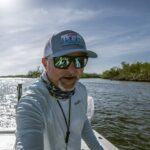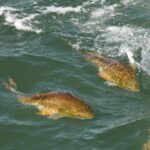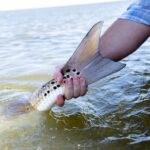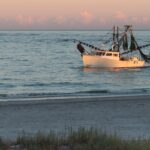
A Veteran Guide’s View of Jacks
If you’ve spent any time on the water in South Florida, chances are you’ve heard
Originally Published Here on Fissues
By Tony Friedrich
On October 4, National Marine Fisheries Service (NMFS) posted an advanced notice of proposed rulemaking (ANPR) regarding fishing for striped bass in the EEZ around Block Island. This move kicks off a process that could have devastating consequences for the future of the striped bass resource.
The specific area is known as the Block Island Transit Zone. Fishing for striped bass is prohibited in federal waters as a conservation measure for the species. This means that in the stretch of federal waters between the mainland and Block Island, fishermen can’t target striped bass. But, recognizing that there are state waters around the island, fishermen have been allowed to “transit” between state water zones with striped bass in their coolers – hence the “Block Island Transit Zone.” This donut hole in the ocean has been the focus of much controversy in recent years. Notably, in 2017, Rep. Zeldin of New York, sponsored H.R. 1195, Local Fishing Access Act.

As summarized by Congress.gov, the bill sought to authorize NMFS to permit and regulate Atlantic striped bass fishing in the Block Island Sound Transit Zone. While H.R. 1195 stalled in Congress, the effort to open the Block Island Transit Zone was just starting to heat up.
Earlier this year, H.R.200, the “Strengthening Fishing Communities and Increasing Flexibility in Fisheries Management Act” was passed on purely partisan votes in the House of Representatives. When bills go to a floor vote, amendments are suggested and voted upon. Well, Rep. Zeldin was able to place H.Amdt.852 into H.R.200. This amendment would open the Block Island Transit area to fishing for striped bass.
H.R. 200 is wildly controversial. So, while this amendment passed the House of Representatives, it is not definitive that it will become law. Strike two for Zeldin’s efforts to open up the EEZ around Block Island for striped bass harvest.
One of the easiest ways to get bad legislation passed is to include it in a budget bill. Well, the Fiscal Year 2018 omnibus appropriations bill was approved earlier this year. It addressed the question of opening federal waters around Block Island as well as the entire EEZ for striped bass harvest.
Now is a great time to grab some ibuprofen and a fresh cup of coffee, you are going to need it.
An omnibus appropriations bill funds or creates a budget for federal agencies. It also gives some direction on how the money is to be spent. The omnibus that passed for FY 2018 contained the following language (pg 42).
Atlantic Striped Bass. —The Atlantic States Marine Fishery Commission is completing a new stock assessment of Atlantic Striped Bass in 2018. After this assessment is complete, the Secretary of Commerce is directed to use this assessment to review the Federal moratorium on Atlantic Striped Bass.
Block Island Transit Zone. —NOAA, in consultation with the Atlantic States Marine Fisheries Commission, is directed to consider lifting the ban on striped bass fishing in the Federal Block Island Transit Zone
The writing was on the wall in August at the ASMFC Striped Bass Management Board meeting. If you click this link, you can hear for yourself. The NFMS representative states the Secretary of Commerce will investigate opening up the Block Island Transit Zone as well as the entire EEZ. He mentioned the stock assessment that is due out in February of 2019 and stated, “Directives that came out of the 2018 Omnibus one was review the federal moratorium on striped bass”. (Hopefully you took those ibuprofen as recommended.)
Nothing good can come of this.
Let’s take a small step back before moving forward because things are about to get complicated. You have to understand this situation. It is very important for the future of striped bass. I’m walking the razor’s edge between understanding and confusion so please just bear with me for a few minutes.
In 2007, President George W. Bush signed Executive Order 13449—Protection of Striped Bass and Red Drum Fish Populations. This executive order bans commercial striped bass and red drum fishing in the EEZ. At the time, it seemed like a great idea. President Bush flew to the Eastern Shore on Marine 1 to make everything official. Many of us who live in the area attended the event and were proud to be a part of it. Red drum have a maximum size in the Atlantic and striped bass fishing was already not allowed in the EEZ so it was seen as a protection for the species and not much else.
Now, this seldom considered order is mucking things up a bit and creating an unprecedented situation in the Atlantic. The current situation is that the directives in the omnibus would mean that only recreational anglers would be able to harvest stripers in the EEZ. It would require another executive order to overturn 13449. Otherwise, it comes down to the federal government opening up federal waters to state management for the harvest of striped bass for just one sector.
As an angler, this doesn’t seem right to me. Don’t get me wrong, we should fight this ill-conceived effort with everything we have. But, it is nothing short of embarrassing to see anglers driving the effort to harvest the most important segment of this dwindling stock – those older larger fish that are known to frequent the EEZ.
I promise, we never saw that coming in 2007. The thought of recreational anglers becoming part of the anti-conservation movement never crossed my mind. This is the biggest miscalculation of my professional life and I’ve had quite a few.
Let’s get back to the issue at hand.
In response to the funding bill, National Marine Fisheries Service has issued an advanced notice of proposed rulemaking to open the area off Block Island for recreational-only harvest of striped bass. While it is being couched as administrative housekeeping it is far from normal in several areas. The text of the ANPR is excerpted below:
NMFS is considering revising current regulations to authorize recreational fishing in the Block Island Transit Zone. This would allow recreational fishermen to harvest, retain, and transport striped bass within the Block Island Transit Zone. The ANPR is in response to the 2018 Omnibus Appropriations Act (Pub. L. 115-141) which included the provision directing “NOAA, in consultation with the Atlantic States Marine Fisheries Start Commission, to consider lifting the ban on striped bass fishing in the Federal Block Island Transit Zone.” (83 Fed. Reg. 50061, Oct. 4, 2018.)
Let’s get into the weeds for a bit.
First, this ANPR came from the National Marine Fisheries Service (NMFS) in Silver Spring, MD. This is very odd. The Silver Spring office usually handles high level policy decisions. Changes to the guidelines for implementing the 10 National Standards of the Magnuson Stevens Act are a good example. Regulation changes affecting local fisheries usually originate with the Greater Atlantic Region Fisheries Office (GARFO), and are then run up the chain to Silver Spring for final approval after the fine details have been hammered out in the region by GARFO, working together with stakeholders. But this time the regulations are coming right from the top. This is a sure indicator of political shenanigans and has nothing to do with the conservation of striped bass. As noted in the ANPR, NOAA/NMFS is consulting with the Atlantic States Marine Fisheries Commission which is not a part of the council system structures under our nation’s most important fisheries law, the Magnuson-Stevens Act.
Why is all of this important? Well, it represents a fundamental and profound change on several levels. This is the first step in opening the entire EEZ for striped bass harvest. Opening the EEZ for striped bass is Pandora’s box. We will never be able to close the box again. This has been the one place that stripers could hide, even if for a little while. They are relentlessly pursued up and down the coast from juvenile to adult. The fish never get a break. If I were a commercial striped bass fisherman, I would be most upset. The commercial sector has taken the cuts assigned in 2012. New Jersey and the Bay states failed to meet the reductions. Currently, they aren’t part of the discussion.
Second and most important, environmental review under the National Environmental Policy Act (NEPA) is absent from the ANPR. The next stage of the process should initiate scoping under NEPA. If there is the potential for a significant change to the environment, an Environmental Impact Statement (EIS) must be produced. At the very least, there needs to be an Environmental Assessment (EA).
Finally, everyone is fully aware that the next benchmark stock assessment for striped bass is due for release in early 2019. Why jump the gun and short change the scientific process? We also know that there is a strong effort to lower the spawning stock biomass reference points for stripers, which would increase the harvest rather than conserve the species by lowering the amount of spawning stock biomass required to be left in the ecosystem. It’s a tricky way of moving the goal post and masking the underlying issues facing the stock.
To wrap all of this up as neatly as possible, let’s review all the issues.
NMFS has published an ANPR to open the EEZ off Block Island. They have been directed to do this by Congress via the Omnibus Appropriations. NEPA review hasn’t even started yet [They have also been directed to investigate opening the entire EEZ to recreational harvest. NMFS will then tackle the opening the entire EEZ for stripers after the stock assessment. Commercial fishermen are completely left out of the process because of Executive Order 13449 which bans commercial harvest for striped bass in the EEZ. The 2019 benchmark stock assessment is coming out in February of 2019. In the meantime, certain states are pushing for lowering the biological reference points for the spawning stock biomass thereby leaving less adult female striped bass in the system.
The Fissues.org team has been warning you for months about the fights we would soon be facing. The fight is now upon us. First things first, please comment to oppose opening the EEZ in any capacity. Click this link to submit comments on this ANPR.

If you’ve spent any time on the water in South Florida, chances are you’ve heard

Photo Credit: Graham Tayloe Big Win for Redfish in Alabama Huge news from the Marine

Feature Photo: Carter Abramson | Simms Fishing at the Fisheries Science Symposium We have more

Each year, hundreds of millions of fish are killed as collateral damage from large-scale, inshore
We rely on our members and donations to keep fighting for a sustainable tomorrow in marine conservation.
GIVE THE GIFT OF FISHERIES CONSERVATION THIS HOLIDAY SEASON. SHOP ASGA GOODS THAT FUND FISHERIES RESEARCH & ADVOCACY CAMPAIGNS
JOIN ASGA IN CALLING FOR CRITICAL MANAGEMENT ACTION AFTER YEARS OF SPAWN FAILURES & POOR MANAGEMENT.
By using this website, you agree to our use of cookies. We use cookies to provide you with a great experience and to help our website run effectively. To learn more, please review our privacy policy.
One Response
Haha wow, I love this man. PLEASE keep posting! Can’t wait to read your next blog!